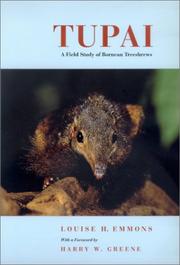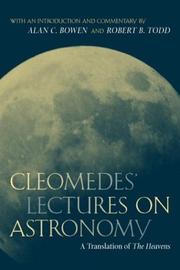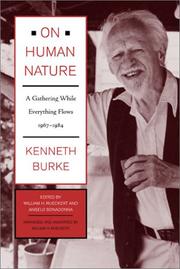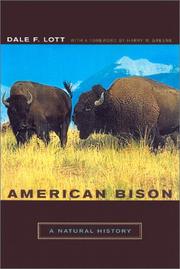| Listing 1 - 10 of 108 | << page >> |
Sort by
|
Book
ISBN: 1452968845 1452968861 1517914833 Year: 2022 Publisher: University of Minnesota Press
Abstract | Keywords | Export | Availability | Bookmark
 Loading...
Loading...Choose an application
- Reference Manager
- EndNote
- RefWorks (Direct export to RefWorks)
Amid the historical decimation of species around the globe, a new way into the language of loss. An endling is the last known individual of a species; when that individual dies, the species becomes extinct. These "last individuals" are poignant characters in the stories that humans tell themselves about today's Anthropocene. In this evocative work, Lydia Pyne explores how discussion about endlings-how we tell their histories-draws on deep traditions of storytelling across a variety of narrative types that go well beyond the science of these species' biology or their evolutionary history. Endlings provides a useful and thoughtful discussion of species concepts: how species start and how (and why) they end, what it means to be a "charismatic" species, the effects of rewilding, and what makes species extinction different in this era. From Benjamin the thylacine to Celia the ibex to Lonesome George the Galápagos tortoise, endlings, Pyne shows, have the power to shape how we think about grief, mourning, and loss amid the world's sixth mass extinction.
Communication in biology. --- Extinction (Biology) --- Species. --- Speciation (Biology) --- Biology --- Genetics --- Hybridization --- Organisms --- Animals --- Extirpation (Biology) --- Extinct animals --- Extinction --- Extirpation --- Nature & the natural world: general interest
Book
ISBN: 1501740865 1501740857 1501740873 Year: 2019 Publisher: Cornell University Press
Abstract | Keywords | Export | Availability | Bookmark
 Loading...
Loading...Choose an application
- Reference Manager
- EndNote
- RefWorks (Direct export to RefWorks)
Nature Guiding is the science of inculcating nature enthusiasm, nature principles, and nature facts into the spirit of individuals. "Doing" nature-study means observing, wondering, and solving problems. It could include collecting, building, measuring, painting, planning, writing, touching, experimenting or any of a wide range of other activities. Most importantly, it allows children to be "original investigators."This book is intended as a resource for teachers and students engaged in nature study at summer camps and in schools. William Gould Vinal believed that the teacher of nature study should be "in sympathy with the simple life and the country way," that the nature study should emphasize observation of the interactions of plants and animals in their environment, and not be reduced to matters of taxonomy and anatomy. In Nature Guiding, he offers advice to camp counselors and school teachers on incorporating nature study into everyday activities, as well as suggestions for parents and others about using visits to state and national parks to teach nature lore.
Camping. --- Nature study. --- Nature Guides & Natural History. --- NATURE / Reference. --- Nature --- Education --- Human ecology --- Natural history --- Biology --- Outdoor recreation --- Camps --- Outdoor life --- Study and teaching --- Fieldwork --- Nature & the natural world: general interest
Book
ISBN: 1283362783 9786613362780 0226736873 9780226736877 6613362786 9781283362788 9780226736853 0226736857 9780226736860 0226736865 Year: 2011 Publisher: Chicago, IL University of Chicago Press
Abstract | Keywords | Export | Availability | Bookmark
 Loading...
Loading...Choose an application
- Reference Manager
- EndNote
- RefWorks (Direct export to RefWorks)
Despite claims to the contrary, the science of ecology has a long history of building theories. Many ecological theories are mathematical, computational, or statistical, though, and rarely have attempts been made to organize or extrapolate these models into broader theories. The Theory of Ecology brings together some of the most respected and creative theoretical ecologists of this era to advance a comprehensive, conceptual articulation of ecological theories. The contributors cover a wide range of topics, from ecological niche theory to population dynamic theory to island biogeography theory. Collectively, the chapters ably demonstrate how theory in ecology accounts for observations about the natural world and how models provide predictive understandings. It organizes these models into constitutive domains that highlight the strengths and weaknesses of ecological understanding. This book is a milestone in ecological theory and is certain to motivate future empirical and theoretical work in one of the most exciting and active domains of the life sciences.
Ecology --- Philosophy. --- theoretical, academic, scholarly, ecological, theories, biology, biologist, science, scientific, math, mathematical, computation, computational, statistics, statistical, population, dynamic, species, dynamics, biogeography, observation, nature, natural world, philosophy, equilibrium, ecosystem, global, change, essay collection.

ISBN: 1597349682 1282355074 9786612355073 0520925041 0520223845 0520222911 9780520925045 0585391580 9780585391588 9780520222915 9780520223844 9781597349680 9781282355071 Year: 2000 Publisher: Berkeley University of California Press
Abstract | Keywords | Export | Availability | Bookmark
 Loading...
Loading...Choose an application
- Reference Manager
- EndNote
- RefWorks (Direct export to RefWorks)
Treeshrews suffer from chronic mistaken identity: they are not shrews, and most are not found in trees. These squirrel-sized, brownish mammals with large, dark, lashless eyes were at one time thought to be primates. Even though most scientists now believe them to belong in their own mammalian order, Scandentia, they still are thought to resemble some of the earliest mammals, which lived alongside the dinosaurs. This book describes the results of the first comparative study of the ecology of treeshrews in the wild. Noted tropical mammalogist Louise H. Emmons conducted this pathbreaking study in the rainforests of Borneo as she tracked and observed six species of treeshrews. Emmons meticulously describes their habitat, diet, nesting habits, home range, activity patterns, social behavior, and many other facets of their lives. She also discusses a particularly interesting aspect of treeshrews: their enigmatic parental care system, which is unique among mammals.
Tupaiidae. --- Zoology --- Health & Biological Sciences --- Vertebrates --- Tupaiidae --- Squirrel shrews --- Tree shrews --- Treeshrews --- Scandentia --- Borneo. --- ancient animals. --- ancient mammals. --- animal behavior. --- animal communication. --- animal diet. --- animal habitat. --- animal life. --- animal lovers. --- animal species. --- animal studies. --- animals. --- diet. --- geography. --- habitat. --- mammalogist. --- mammals. --- natural history. --- natural world. --- nesting. --- rainforest. --- regional. --- social behavior. --- treeshrews. --- world history.

ISBN: 0520233255 9780520928510 0520928512 1417508280 9781417508280 1597345466 9781597345460 128235678X 9786612356780 9780520233256 Year: 2004 Volume: 42 Publisher: Berkeley University of California press
Abstract | Keywords | Export | Availability | Bookmark
 Loading...
Loading...Choose an application
- Reference Manager
- EndNote
- RefWorks (Direct export to RefWorks)
At some time around 200 A.D., the Stoic philosopher and teacher Cleomedes delivered a set of lectures on elementary astronomy as part of a complete introduction to Stoicism for his students. The result was The Heavens (Caelestia), the only work by a professional Stoic teacher to survive intact from the first two centuries A.D., and a rare example of the interaction between science and philosophy in late antiquity. This volume contains a clear and idiomatic English translation-the first ever-of The Heavens, along with an informative introduction, detailed notes, and technical diagrams. This important work will now be accessible to specialists in both ancient philosophy and science and to readers interested in the history of astronomy and cosmology but with no knowledge of ancient Greek.
Astronomy, Greek. --- Astronomy --- Astronomy, Greek --- 520.938 --- Greek astronomy --- Physical sciences --- Space sciences --- Sciences Astronomy History Ancient World Greece --- Astronomy - Early works to 1800 --- alexandria. --- ancient greece. --- ancient greeks. --- ancient philosophy. --- astronomy. --- caelestia. --- cleomedes. --- cosmology. --- cosmos. --- greek philosophy. --- hellenism. --- metaphysics. --- moral philosophy. --- natural world. --- nonfiction. --- philosophy. --- science and philosophy. --- social philosophy. --- stoic philosopher. --- stoic philosophy. --- stoicism. --- the heavens. --- zodiac.

ISBN: 0520219198 0520923065 1597347825 9780520923065 0585456313 9780585456317 9781597347822 9780520219199 Year: 2003 Publisher: Berkeley University of California press
Abstract | Keywords | Export | Availability | Bookmark
 Loading...
Loading...Choose an application
- Reference Manager
- EndNote
- RefWorks (Direct export to RefWorks)
On Human Nature: A Gathering While Everything Flows brings together the late essays, autobiographical reflections, an interview, and a poem by the eminent literary theorist and cultural critic Kenneth Burke (1897-1993). Burke, author of Language as Symbolic Action, A Grammar of Motives, and Rhetoric of Motives, among other works, was an innovative and original thinker who worked at the intersection of sociology, psychology, literary theory, and semiotics. This book, a selection of fourteen representative pieces of his productive later years, addresses many important themes Burke tackled throughout his career such as logology (his attempt to find a universal language theory and methodology), technology, and ecology. The essays also elaborate Burke's notions about creativity and its relation to stress, language and its literary uses, the relation of mind and body, and more. Provocative, idiosyncratic, and erudite, On Human Nature makes a significant statement about cultural linguistics and is an important rounding-out of the Burkean corpus.
Criticism --- Philosophy --- Mental philosophy --- Evaluation of literature --- Literary criticism --- Literature --- Technique --- Evaluation --- Humanities --- Rhetoric --- Aesthetics --- Criticism. --- Philosophy. --- archetype. --- conservation. --- correspondence. --- creativity. --- cultural critic. --- cultural linguistics. --- ecology. --- environment. --- essays. --- great thinkers. --- human nature. --- language. --- linguistics. --- literary theory. --- logology. --- marginalia. --- mind and body. --- natural world. --- nature. --- nonfiction. --- psychology. --- rhetoric. --- semiotics. --- social commentary. --- sociology. --- stress. --- technology. --- universal language theory.

ISBN: 1597344591 1282759272 9786612759277 0520930746 9780520930742 1417522682 9781417522682 9780520233386 0520233387 0520240626 9780520240629 Year: 2002 Publisher: Berkeley University of California Press
Abstract | Keywords | Export | Availability | Bookmark
 Loading...
Loading...Choose an application
- Reference Manager
- EndNote
- RefWorks (Direct export to RefWorks)
American Bison combines the latest scientific information and one man's personal experience in an homage to one of the most magnificent animals to have roamed America's vast, vanished grasslands. Dale F. Lott, a distinguished behavioral ecologist who was born on the National Bison Range and has studied the buffalo for many years, relates what is known about this iconic animal's life in the wild and its troubled history with humans. Written with unusual grace and verve, American Bison takes us on a journey into the bison's past and shares a compelling vision for its future, offering along the way a valuable introduction to North American prairie ecology. We become Lott's companions in the field as he acquaints us with the social life and physiology of the bison, sharing stories about its impressive physical prowess and fascinating relationships. Describing the entire grassland community in which the bison live, he writes about the wolves, pronghorn, prairie dogs, grizzly bears, and other animals and plants, detailing the interdependent relationships among these inhabitants of a lost landscape. Lott also traces the long and dramatic relationship between the bison and Native Americans, and gives a surprising look at the history of the hide hunts that delivered the coup de grâce to the already dwindling bison population in a few short years. This book gives us a peek at the rich and unique ways of life that evolved in the heart of America. Lott also dismantles many of the myths we have created about these ways of life, and about the bison in particular, to reveal the animal itself: ruminating, reproducing, and rutting in its full glory. His portrait of the bison ultimately becomes a plea to conserve its wildness and an eloquent meditation on the importance of the wild in our lives.
American bison. --- Bison --- Bisons --- Bovidae --- American buffalo --- Bison, American --- Bison americanus --- Bison bison --- Bison occidentalis --- Bison sylvestris --- Bos bison --- Buffalo, American --- american animals. --- animal life. --- animal relationships. --- bison population. --- bison range. --- bison. --- buffalo. --- ecologist. --- ecology. --- endangered species. --- fauna. --- grasslands. --- grizzly bears. --- iconic. --- interspecies. --- myths. --- native animals. --- natural world. --- nature. --- nonhuman animals. --- north america. --- prairie dogs. --- prairie ecology. --- prairie. --- relationships. --- scientific. --- social life. --- wilderness.

ISBN: 1597347140 9786612359606 1282359606 0520936809 9780520936805 1417525649 9781417525645 9781597347143 9780520213128 0520213122 9780520236288 0520236289 0520213122 0520236289 6612359609 9781282359604 Year: 2003 Publisher: Berkeley University of California Press
Abstract | Keywords | Export | Availability | Bookmark
 Loading...
Loading...Choose an application
- Reference Manager
- EndNote
- RefWorks (Direct export to RefWorks)
Robert Thayer brings the concepts and promises of the growing bioregional movement to a wide audience in a book that passionately urges us to discover "where we are" as an antidote to our rootless, stressful modern lives. Life Place is a provocative meditation on bioregionalism and what it means to live, work, eat, and play in relation to naturally, rather than politically, defined areas. In it, Thayer gives a richly textured portrait of his own home, the Putah-Cache watershed in California's Sacramento Valley, demonstrating how bioregionalism can be practiced in everyday life. Written in a lively anecdotal style and expressing a profound love of place, this book is a guide to the personal rewards and the social benefits of re-inhabiting the natural world on a local scale. In LifePlace, Thayer shares what he has learned over the course of thirty years about the Sacramento Valley's geography, minerals, flora, and fauna; its relation to fire, agriculture, and water; and its indigenous peoples, farmers, and artists. He shows how the spirit of bioregionalism springs from learning the history of a place, from participating in its local economy, from living in housing designed in the context of the region. He asks: How can we instill a love of place and knowledge of the local into our education system? How can the economy become more responsive to the ecology of region? This valuable book is also a window onto current writing on bioregionalism, introducing the ideas of its most notable proponents in accessible and highly engaging prose. At the same time that it gives an entirely new appreciation of California's Central Valley, LifePlace shows how we can move toward a new way of being, thinking, and acting in the world that can lead to a sustainable, harmonious, and more satisfying future.
Bioregionalism. --- Environmentalism --- Human ecology --- bioregional movement. --- bioregionalism. --- california. --- case study. --- environmental studies. --- fauna and flora. --- indigenous peoples. --- local agriculture. --- local economies. --- local geography. --- local living. --- local residents. --- modern lives. --- natural living. --- natural world. --- nonfiction. --- place history. --- putah cache watershed. --- regional ecology. --- regional history. --- sacramento valley. --- social and cultural. --- sustainable business. --- sustainable living. --- textbooks. --- work and play. --- working locally.

ISBN: 1281966207 9786611966201 0226668053 9780226668055 0226668061 9780226668062 9781281966209 661196620X Year: 2001 Publisher: Chicago University of Chicago Press
Abstract | Keywords | Export | Availability | Bookmark
 Loading...
Loading...Choose an application
- Reference Manager
- EndNote
- RefWorks (Direct export to RefWorks)
Energy is crucial for events of every kind, in this world or any other. Without energy, nothing would ever happen. Nothing would move and there would be no life. The sun wouldn't shine, winds wouldn't blow, rivers wouldn't flow, trees wouldn't grow, birds wouldn't fly, and fish wouldn't swim; indeed no material object, living or dead, could even exist. In spite of all this, energy is seldom considered a part of what we call "nature." In The Energy of Nature, E. C. Pielou explores energy's role in nature-how and where it originates, what it does, and what becomes of it. Drawing on a wide range of scientific disciplines, from physics, chemistry, and biology to all the earth sciences, as well as on her own lifelong experience as a naturalist, Pielou opens our eyes to the myriad ways energy and its transfer affect the earth and its inhabitants. Along the way we learn how energy is delivered to the earth from the sun; how it causes weather, winds, and tides; how it shapes the earth through mountain building and erosion; how it is captured and used by living things; how it is stored in chemical bonds; how nuclear energy is released; how it heats the unseen depths of the planet and is explosively revealed in the turmoil of earthquakes and volcanoes; how energy manifests itself in magnetism and electromagnetic waves; how we harness it to fuel human societies; and much more. Filled with fascinating information and helpful illustrations (hand drawn by the author), The Energy of Nature is fun, readable, and instructive. Science buffs of all ages will be delighted. "A luminous, inquiring, and thoughtful exploration of Earth's energetics."-Jocylyn McDowell, Discovery
Force and energy. --- Physics. --- Natural philosophy --- Philosophy, Natural --- Physical sciences --- Dynamics --- Conservation of energy --- Correlation of forces --- Energy --- Physics --- Power resources. --- natural world, outdoors, academic, scholarly, research, science, scientific, interdisciplinary, disciplines, earth, sciences, naturalist, physics, chemistry, biology, erosion, mountains, chemical, bonds, nuclear, earthquake, volcano, sun, solar, electromagnetic, waves, illustrated, illustrations, college, university, higher ed, energetics, ocean, atmosphere, wind, sea, seismic. --- Force
Book
ISBN: 1282917854 9786612917851 0520947339 9780520947337 9780520262874 0520262875 9781282917859 6612917857 Year: 2011 Publisher: Berkeley University of California Press
Abstract | Keywords | Export | Availability | Bookmark
 Loading...
Loading...Choose an application
- Reference Manager
- EndNote
- RefWorks (Direct export to RefWorks)
This essential collection of Michael McClure's poetry contains the most original, radical, and visionary work of a major poet who has been garnering acclaim and generating controversy for more than fifty years. Ranging from A Fist Full, published in 1957, through Swirls in Asphalt, a new poem sequence, Of Indigo and Saffron is both an excellent introduction to this unique American voice and an impressive selection from McClure's landmark volumes for those already familiar with his boldly inventive work. One of the five poets who heralded the Beat movement in the 1955 Six Gallery reading in San Francisco, McClure reveals in his poetry a close kinship to Romanticism, Modernism, Surrealism, and Japanese haiku. These poems-grounded in imagination and a profound regard for the natural world-chart a poetic landscape of utter originality.
American poetry. --- American literature --- 20th century poets. --- american poets. --- american. --- beat movement. --- beat poets. --- beauty. --- book club reads. --- california. --- controversial. --- essential collection. --- famous poets. --- humanity. --- imaginative. --- introduction to poetry. --- inventive. --- japanese haiku. --- modernism. --- natural world. --- nature poems. --- poem sequence. --- poems. --- poetic landscape. --- poetry collection. --- radical poetry. --- romantic poetry. --- romanticism. --- san francisco. --- six gallery reading. --- surrealist poetry. --- visionary work.
| Listing 1 - 10 of 108 | << page >> |
Sort by
|

 Search
Search Feedback
Feedback About UniCat
About UniCat  Help
Help News
News